Joe Bagley, Boston City Archaeologist
Friends of the Blue Hills Keynote
Annual Celebration
October 9, 2014
In 2002, I found myself on the shores of Naskeag Point, Maine overlooking Mt. Desert Island on my first archaeological dig. I was mere months from beginning college at Boston University’s Archaeology program hoping, desperately, that I would enjoy the experience of spending a day leaning over a hole in the ground digging up bits of broken things. One lunch break, our crew was brought to the nearby beach for a demonstration. I was handed truncated deer antler and a chunk of blue stone and instructed to hit the stone with the antler.
The point of the exercise was to learn flintknapping, the ancient art of making a stone tool. I left that summer with not only a deep love for the history of Native Americans which I maintain to today, but also an entirely-unexpected passion for ancient stone tools. This interest continued through my undergrad experience resulting in the revival of a long-dead flintknapping club at BU.
While settling in Boston and pursuing a graduate program in archaeology at UMass Boston my interest in local lithic resources peaked. Lithics, in general, is the broad term archaeologists give to stone tools. As a general rule the two most helpful descriptors of any stone tool is “what is its shape,” which allows us to date the tool to a general time period, but also partially determine what the stone tool may have been used for. The next main descriptor is the raw material the stone is made from. Generally speaking there are “local” stones which come from the general vicinity of an archaeological site, and more “exotic” materials that have traveled great distances.
A great example of a common “exotic” is Pennsylvania Jasper, which comes from a single resource in a town just outside of Allentown PA, 300 miles away, and turns up in great quantities in Massachusetts, for reasons still quite unknown, about 2-3 thousand years ago.
For those of you who are wondering what any of this has to do with the Blue Hills, I promise there is a point to all of this.
While pursuing my graduate degree in the slightly unrelated field of Historic archaeology, I decided that I would make it a goal to visit and document as many of the known lithic quarries that existed in and around Boston.
These quarries were the locations, many of them unique to the world, where particular stones with particular physical characteristics could be extracted from the earth or an outcrop and transformed into stone tools. These specific characteristics are high quantities of silica, which makes the edges of these tools both strong and sharp, and a fine grained structure, which allows these stones to break smoothly and with predictable results. While researching the literature on
New England lithic resources, I was amazed by two facts: First, these resources were exceedingly rare due to the fact that many had to come from volcanic origins, and by volcanic I do not mean cooled lava underground, but in fact true volcanoes, and the second fact was that Boston, within New England, contained the greatest concentration of stone resources by a great measure, and more to the point of this discussion, the Blue Hills contained the greatest concentration of resources within the Boston area.
So what does this all mean?
First, this means that 600 million years ago the Blue Hills did not look like the small hilly landscape of today, but rather a true, conical volcano like you would see on the west coast.
After erupting, or rather EXPLODING, the volcano that would become the Blue Hills formed a large Caldera that further collapsed and eroded over hundreds of millions of years leaving behind the mountainous and cobbled surface we all love today.
That volcano is directly responsible for producing half dozen outcrops of stone used by Native Americans for thousands of years.
The slate that formed in the low lying areas of Boston was cooked by the rising plumes of granitic lava that would go on to make the Quincy granite melting and restructuring the platy material into a glassy dense black stone beloved by Native Americans for its color and smooth texture. The lava from the original volcano formed massive formations of stone across the Blue Hills ranging in size from large boulders to entire mountains.
The Blue Hills are nothing short of an archaeological wonder of epic proportions. In 2012, I set out on a day-long hike in the Blue Hills Reservation with my wife, Jen, who is also an archaeologist. Utilizing the documents previously published regarding the location of outcrops of blue hills rhyolite, Braintree slate, and Massachusett hornfels, we sought out these locations to document and witness the natural environment of a Native Landscape. We were absolutely blown away.
I have personally visited, excavated, and studied hundreds of Native archaeological sites throughout the east coast, and I have never experienced the types of intact Native landscapes that can be found in the Blue Hills. I do not mean intact as in undeveloped, but intact meaning the actual experience is similar today as it was in the past.
Here’s the thing about Native quarries: People travel great distances to find these natural resources, but the resource itself is a rock, and it is by its very nature heavy. That means that the people who came to the Blue Hills did not do so to carry back large boulders like some sort of deer kill triumphantly dragged back to camp.
Instead, what we find is workshops surrounding these outcrops of stone where people dug out or broke off portions of the rhyolite, slate, and hornfels occurring here, and nowhere else in the world, and roughly broke down these angular fragments into “preforms,” which are essentially partially-made stone tools. These preforms were much easier, and lighter, to transport throughout the region, but also economically sensible as the larger rough stones did not need to be carried, nor were the far more fragile and delicate finished tools needed to be transported back to camps and villages where they were more likely to break during transportation.
Over thousands of years, these workshops form piles of stone fragments, each representing moments in time— seconds in a person’s life who lived here thousands of years ago.
Wampatuk hill, one of the many that make up the ridges of the Blue Hills, is made entirely out of a material called rhyolite. Essentially this hill represents a portion of the lava column located within the volcano that solidified so quickly that it’s silica (or glass)- rich magma turned into a crystalline fine grained blue rock with tiny flecks of quartz. It is the natural blue color of the stones of the Blue Hills that gave the area its name, and it is this one particular type of blue stone that brought Native people from the surrounding area to Wampatuk to mine and work its natural stone. The entire area surrounding the hill consists of massive boulders and outcrops of blue hills rhyolite, each one slightly different, and each one a type of stone that I have found turned into tools that we excavate on archaeological sites throughout the area. These range from the deep blue-black stones east and south of Wampatuk to the oddly speckled material you find on Wampatuk itself. This hill was a Mecca of stone tool production.
As you walk the Sawcut Notch path along the northern boundary of the park, you will pass great dome and little dome. These two small hills are made out of Braintree slate and Massachusett hornfels. Keep an eye open for scoop-like marks in the stone where thousands of years before a Massachusett Native person was standing exactly where you are striking the slate to remove portions of it to turn into tools. Turn around and behind you will be small mounds of stone fragments.
These mounds are not natural deposits, but heaps of stone waste, each the result of stone striking stone working raw slate down to a spear preform or perhaps a stone adz. These are all viewable from the path and artifacts lie within the path itself.
This location embodies the amazing power of place. There are dozens of small unnamed hills throughout the Blue Hills, yet great dome and little dome have a name. Why is that? I believe that humans have an innate perception for the power of place. This is not some pseudo-science or mystical sixth sense, but we know when we are in an important or good place. There is something deep down inside that tells us…this is right. I like it here. You have all probably experienced this yourselves in the Blue Hills. If we broke it down it would be that the soils are sandy and it allows for drainage that would keep the ground dry if you needed to build your home. It could also be a dramatic view, or a nice place to sit by a stream, etc. The reactions we have to these places are our human instincts peeking out from inside. It is the same reason why archaeologists are constantly finding Native sites under early colonial sites. The same reasons a person would want to live somewhere in the 1700s is usually the same 6,000 years ago. I believe the quarries, the modified landscape, and the pathways through little and great dome hills created a truly palpable sense of place that elevated this location to the point where the hills were formally recognized and named in the historic period.
Further west, by the pipeline building, I came upon another quarry site. Again, these are not new discoveries I have made, these quarries were published decades ago. The terraced hills seemed to trace the erosional record of the past few million years exposing large areas of Braintree slate. As I walked through the area, I found it difficult to find the quarry that was written about in the documents I had read. About half-way up the hill I noticed some Braintree flakes at my feat, indicating that I had finally found the quarry area. That said, I was at least 40 feet from the nearest outcrop. As I began to search the ground around me, I had the adrenaline-inducing realization that while I had been climbing up this terraced hillside of rocks looking for a quarry, I had completely missed it simply because I had utterly underestimated the scale of what I would find.
The natural hillside was not in fact natural, it was, and IS, a quarry of truly monumental proportions. The terraces I had walked were not simply erosional, but were in fact carved into the raw rock by Massachusett Native people quarrying stone from the hillside for thousands of years, and the mounds and pathways I had been climbing over were mountains of stone debris consisting of Millions upon millions of stone flakes each individually struck by human hands.
I literally stood there for several minutes in complete silence not quite able to grasp the scale of the place, and floored by the simple fact that the hillside, these terraces, and the heaps of stone surrounding me are not only one of the most significant archaeological and historical features of New England, but are essentially unchanged from the moment they were made thousands upon thousands of years ago.
Braintree Slate was most popularly used between 5,000-8,000 years ago, especially for ground stone tools. Stand near these quarries and remind yourself that when that stone pile was made, the Giza plateau had not yet seen the construction of a single pyramid.
The hills of Wiltshire, England had not yet seen the construction of Stonehenge, and Romulus and Remus would not found Rome for many thousands of years… and yet these stone were here. PEOPLE were here, and thousands of years ago this place mattered.
This is a truly sacred landscape to the Massachusett People. The prominence of Great Blue Hill, the tallest hill within 10 miles of the Atlantic Coast, south of Maine, was a landmark that all on the eastern side of Massachusetts could see. The surrounding hills were life givers in the sense that Native people could harvest raw stone from the ground, transform them into tools, and use those tools to hunt animals, process their food, cut down trees for structures, and hollow out large trunks for canoes. The fresh water of Ponkapaog Pond lies adjacent to one of the largest Archaic Massachusett village site, dating to between 3,000 and 8,000 years old where those preforms I discussed earlier were brought in great quantity to process into ulus, ground adzes, spear points, and other tools. The rivers and streams provided fresh water for hundreds of people and some of the very same paths you walk today were first blazed by the feet of Massachusett people 8,000. 10,000. 12,000 years ago.
The importance of this place to the Native people who have and continue to use the Blue Hills is recorded through both the stones that have been left to lie for so many millennia and the current population of the Massachusett Ponkapoag tribe who cite the Blue Hills as the center of their community in the past and today. That all said, it takes two to do the stewardship tango. It is the stewardship of the present community that works to preserve the stewardship of the past. Each one of the sites I discussed here are open to the public, and artifacts by the thousands are easy to carry away, but it is the intact preservation of these sites, and the stewardship of the history they record, that is critical to the importance and continued significance of this place. In other words, these stones absolutely must stay preserved as and where they lay.
Nowhere in Massachusetts can you so clearly walk in the footstep of the ancient past along trails that are older than we can truly comprehend, past sites and places that have been sacred to the many Native and non-native people who have visited this place for so many years.
The power of place is truly clear in the fact that in 1893 this land was one of the first parcels purchased by the state and set aside, FOREVER, for the active, passive, and contemplative recreation of all. It is with great gratitude that I am here to speak to you today about a place that I love. I thank you all for the 35 years of effort you have made to preserve, to protect, and to promote this incredible place we have today. Whether you know it or not, you are not just the caretakers and stewards of the natural and ecological beauty that is the Blue Hills Reservation, but you are also the protectors of one of the greatest historical treasures in New England. Thank you for inviting me here today.
Thank you for all of the great work you do.
And Thank you for the tireless effort you make towards preserving the many aspects that makes this place important to all.
Photo: Brian McLean, Milton

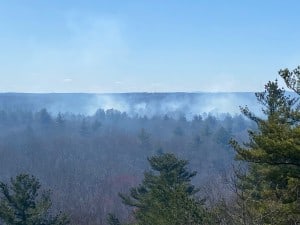

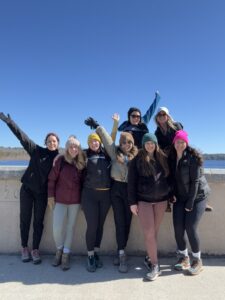


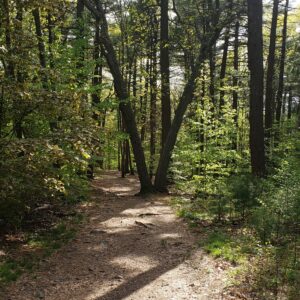
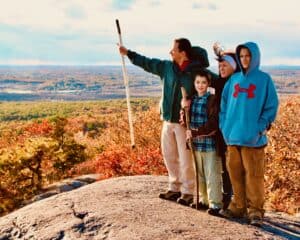


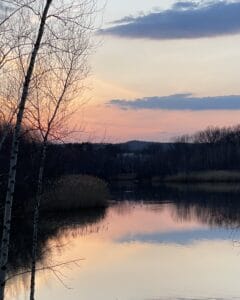
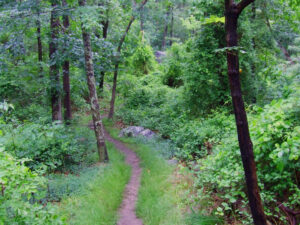
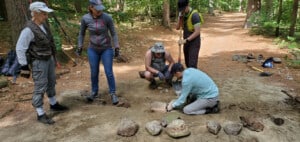
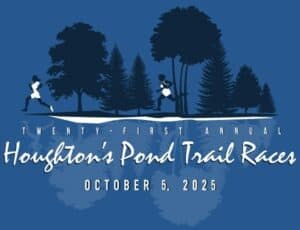
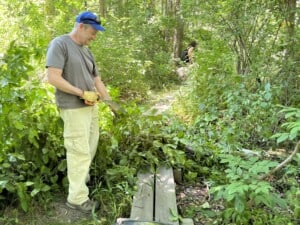
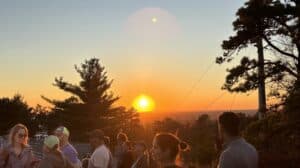
Wow, 8 years late, but this is an awesome keynote! Thank you Brian. Have been ambling in the Blue Hills for 50+ yrs and have hiked all those spots, but had no idea. I clearly need to do more exploring in the Blue Hills! It is a special place indeed.
So glad you found this post — and liked it!
Love the article I spent the better part of 25 summers at AMC camp on Ponkapoag Pond. We used to hike to a rock formation called Lemon Squeeze.when kid I found many arrow heads there. I can remember which train from camp gets me there. can anyone help. Thanks in advance Cheryl FRASER
I’m so glad you have such fond memories! There isn’t a train that goes to Ponkapoag. Maybe you took a bus that was associated with the camp?
I read the article and took a hike over to big dome. I looked down on the trail noticing greyish blue stone polished by people walking on the trail and realized this is the debitage left by these ancient people. A beautiful moment!
We feel the same way. So glad you appreciate the Blue Hills and the people who’ve lived here.
Wow, great article! The first time I hiked past the domes I thought they were very cool, and I idly wondered about the native Americans who used to live there. However, I totally missed the details of the stone workings. I can’t wait to go back and see this and the other sites again through fresh eyes. Thanks very much for sharing this piece and giving others a revitalized appreciation for this fabulous park.
Without doubt the best and most inspiring read about the Blue Hills.
Right, I’m off for a hike.
Excellent response!
I have been going to the Blue Hills for all 30 years of my life and although I knew (inherently, as the author suggests) that it was a special place, I never imagined that its history (geological, archaeological, cultural) was so rich. Thank you for this fabulous piece – it gives me an even stronger love for my home.
So glad you liked it, Derek!
Nice piece. I’d love to go on a walk, guided by the author, through these old quarries.
Thanks for your suggestion! We hope to follow-up with him in the future for something. A walk would be great!